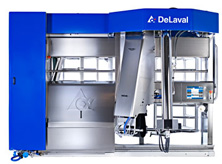Robots are used for myriad applications, including welding, painting, palletizing and assembly. Now, dairy farmers are using them milk cows.

Enter-stage left-automation in the form of robotic milking. Milking machines have been in use for years, of course, but they still require numerous manual operations to get the job done. And, generally speaking, milking must still be done on a rigid schedule. Not so at the Russell Buchholz farm in Malta, IL. As reported recently inPoint of View, the DeKalb County (IL) Farm Bureau’s newspaper, Buchholz’s dairy cows are now on their own schedule with the help of twoVoluntary Milking Systems (VMS) from DeLaval. The firm has been making these robotic milkers for 10 years. While robotic technology has been used extensively in Europe, the Buchholz installation is the first in Illinois.
Each of the 116 cows is fitted with an electronic collar that identifies that cow to the computer controlling the system. When a cow decides to be milked, she enters an entry lock where she is identified. If a sufficient amount of time has elapsed since her last milking, the cow is allowed to enter and given a dietary concentrate. A multipurpose robotic arm then extends underneath the cow and, guided by laser and photo sensors, cleans and dries each teat before attaching vacuum milking cups.
Milk flow, quantity and milking time are monitored individually for each of the cow’s four teats, and compared with historical values. After milking, the vacuum cup lines are retracted, and the robotic arm sprays the cow’s underside with a disinfectant. The gate then opens, releasing the cow to the feeding area, and the VMS system cleans itself before allowing the next cow to enter.
Although automation and robotics have progressed to an extent unimaginable 50 years ago, there are still areas where the “you can’t automate that” mindset impedes their application. Dairy farming was one such area not many years ago. But people like the Buchholz family will expand the automation envelope into new areas in the years ahead.
Recent Comments
Helpful for Trainees
Cable Assembly Manufacturers
Huawei for manufacturing?
should have a scanner and then 3D print the repair
IPC-A-610 and IPC-j-std-001